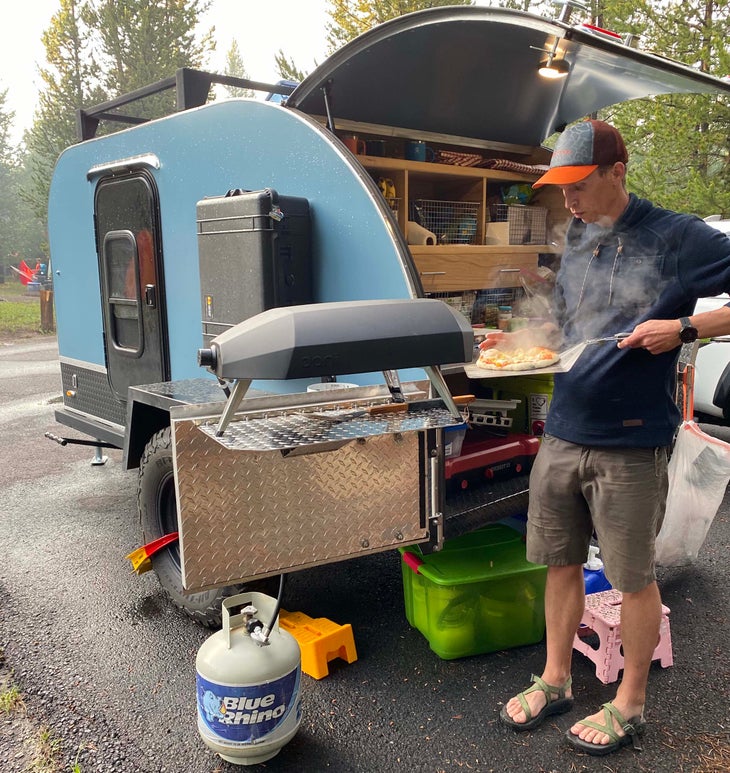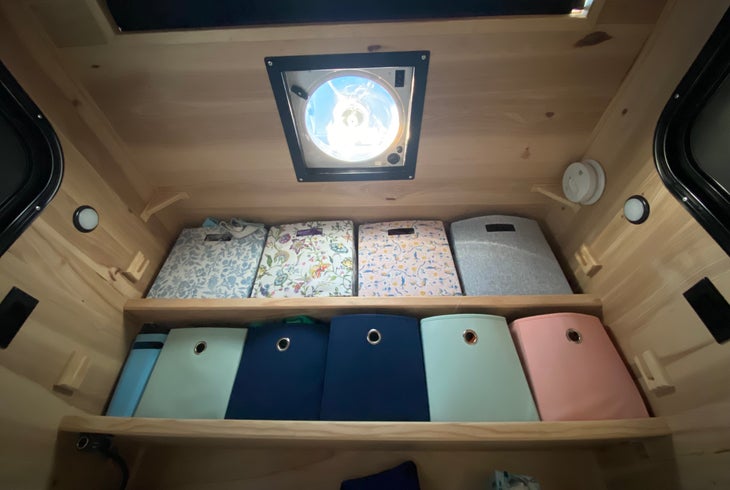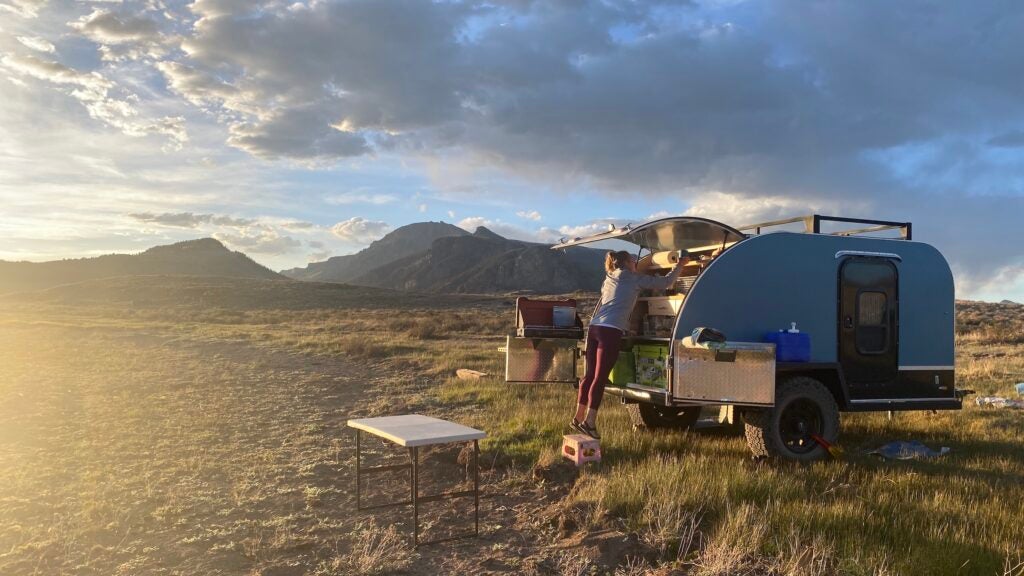No products in the cart.
Outdoor Adventure
Can a Teardrop Trailer Work for a Family of Four?
My husband and I love to camp. So when our identical twins were born in March 2017, our first big purchase that didn’t involve a trip to Babies “Я” Us was a gigantic tent from REI. In theory it was a good acquisition: something the entire family could use as a basecamp for adventuring and exploring new places.
Our girls are almost six now, and I can count on one hand the number of times we’ve used that tent. In our experience, tent camping is a lot of effort in exchange for very little sleep. And, as all parents know, sleep is precious. We defaulted to day trips or AirBnBs simply so we could feel rested enough to keep up with our kids and enjoy whatever activities we had planned.
But we still wanted the camping experience: setting off on far-flung adventures that leave you just the right amount of grimy and exhausted; sipping coffee on a crisp morning while wrapped in a blanket; sitting around a campfire with an adult beverage while the kids feast on s’mores; and participating in all the other things that come along with getting off the grid and out into nature.
We started thinking that a teardrop trailer might be the solution to our sleepless nights. But it had to sleep four people.
We started thinking that a teardrop trailer—essentially an enclosed mattress on wheels with a rear-facing, outdoor galley kitchen—might be the solution to our sleepless nights. We didn’t need a cushy seating area or a refrigerator or a bathroom. We just needed something that could be pulled anywhere by our Tacoma and would allow us to get some shut eye.
Oh, and it had to sleep four people.
Many teardrops (including one awesome Wibtech that we rented from Outdoorsy to confirm we wanted to go the teardrop route) accommodate rooftop tents, but we wanted the entire family to sleep inside the trailer, at least while the girls are little. This narrowed down our options considerably, but we dutifully set out to research all of them. My husband, a scientist and spreadsheet guru, masterfully organized our findings into rows and columns of data that helped us determine what to purchase.
The clear winner—based on sleeping capacity, overall quality, and off-road capability—was the Summit Pinnacle from Boulder-based Colorado Teardrops. We ordered one in September 2020 and due to pandemic-induced supply chain issues, the skyrocketing popularity of teardrops, and Colorado Teardrops being such a small company, we drove away with a sky blue beauty eight months later.

We’ve now had our Summit Pinnacle for almost two years. We’ve had zero regrets and many restful nights. We’ve camped dozens of times already—spending a long fall weekend in Crested Butte, Colorado; Thanksgiving at City of Rocks State Park in southern New Mexico; and spring break at the Grand Canyon, just to name a few incredible destinations—and each time has been a truly enjoyable experience. We even spent nine days in Yellowstone and Grand Teton National Parks, something we never would have done if we were tent camping.
You can geek out on the nitty-gritty specs of the Summit Pinnacle on Colorado Teardrop’s website, but the abridged version is that this trailer can fit in most garages. The body of the trailer is about five feet wide and 10.5 feet long. If you’re measuring the tongue and wheels (which sit outside the cabin), the footprint is a little larger.
The whole thing weighs 1,950 pounds (and quite a bit more once it’s loaded up with food, water, clothing, and other supplies). My husband and I naively thought we’d be able to move it (unhitched) just the two of us, but we were very, very wrong. It sat awkwardly in our driveway for two days before a trailer dolly from Amazon saved the day. Now, just one of us can reposition the trailer on flat, paved surfaces.
In the wild, of course, the Summit Pinnacle’s high ground clearance, skid plate, axle-less design, and rugged tires help us get as far from flat, paved surfaces as possible. Once we’ve reached a destination, we use our truck to more or less position the trailer where we want it. We also use a jack to move the front of the trailer up or down so that the body is level (leveling gauges on the tongue help us dial in the perfect height).
The trailer is framed with structural aluminum and has gorgeous hickory wood walls in the cabin and galley and prefinished aluminum (available in many colors) on the outside. The trailer is fully insulated; in fact it’s so airtight that you’re supposed to crack a window or pop up the roof-top vent at night to prevent carbon monoxide poisoning. Both the windows and the vent have screens, which is great for keeping out bugs, especially when the lights are on inside. The vent also contains a fan, which sucks out hot air and provides some white noise that can be helpful when getting the kids to bed.

And speaking of bed, the Summit Pinnacle has two kid-size (five feet long by 21 inches wide) bunks that run the width of the trailer on the side closest to the hitch. A company in Denver makes custom mattresses (sold separately) for these bunks, although we know some folks who use lawn-chair cushions. The twins have slept great in the bunks, which means that mom and dad also sleep great on their memory foam queen-size mattress (included).
Another factor that contributes to my good sleep is that I feel really safe in the trailer. A friend was nearly killed by a bear a couple summers ago, and the unprovoked attack really spooked me. Even though we take all the bear-safety precautions while camping, I definitely appreciate hard walls between me and wildlife at nighttime.
During the daytime, the queen mattress can fold into a couch on one side of the trailer, and the bunk beds can convert into a couch on the other. In between, you can set up a small table that’s stored under the queen mattress. Essentially this set up forms a little living room that gets great natural light from a big skylight above. Admittedly, we’ve yet to use this setup because we prefer to be outside, but I’m sure the day will come when we’re caught in a thunderstorm and need a dry space to hang out.
Opposite the bunk area is a storage zone where we keep clothing bins. We easily have enough space to pack clothes (including lots of layers) for four people for a week-long trip. There’s also storage under the queen mattress, which is great for things we don’t use too often, such as spare sheets and extra toilet paper (for our Luggable Loo, $26).
On the outside, the galley kitchen offers four levels of storage space. We purchased wire-mesh bins from Target for the middle levels. One is full of staples—things like spices, oils, coffee, and whiskey—that never leave the trailer unless items need to be topped off. Otherwise, before each trip, we carefully organize the dry food into the other bins. Cold items go in the cooler (we have an Engle 65), which sits on a special pull-out shelf on the bottom level.
The Summit Pinnacle uses high-quality components, is thoughtfully designed, and is built to last generations.
The galley’s food preparation area is almost as spacious as our home kitchen. It consists of a large countertop and two pop-out shelves on the lower galley doors that are the perfect size for a camp stove or an Ooni Koda 12 ($400). Conveniently, one of the doors swings back toward the 11-gallon propane tank that’s mounted on the side of the trailer so it’s easy to connect quickly and get cooking.
The propane also instantly heats up water from the trailer’s 11.6-gallon water tank for the shower that we opted to install on the side of the trailer. Excessive? Yes. But it sure is nice to fall asleep clean at the end of the day. Last summer, I ran a half-marathon in the middle of a camping trip, and the post-race shower inside a Green Elephant privacy tent ($80) was almost as priceless as sleeping well the night before the race.
The trailer is powered by a portable Goal Zero 400 ($450), which can be stored out of sight below the bottom bunk or in the galley. This battery powers the interior, exterior, and galley lights, as well as any electronics that are plugged into the USB ports. The battery charges when the trailer is plugged into a running vehicle; this is also how the brake lights, turn signals, and electric brakes get power. The electric brakes, in particular, make easy driving even easier. We cruised up and down Teton Pass and hardly felt the trailer on the 10 percent grade.
If you’ve read this far, you’re likely wondering how much of a dent the Summit Pinnacle put in our bank account. Starting at $32,000, the trailer is more pricey than many teardrops on the market. But, as I’ve hopefully demonstrated here, it uses high-quality components, is thoughtfully designed, and is built to last generations. The folks at Colorado Teardrops are easy to work with, happy to customize trailers to their customers’ needs, and committed to making quality teardrops. After ordering the trailer, we drove up to Boulder to tour their shop and talk about customizations with the staff. The owner, Dean Wiltshire, commented that one day our kids will inherit the trailer. My husband and I certainly hope that’s the case—but only after we get many decades of use out of it first.
Source link

